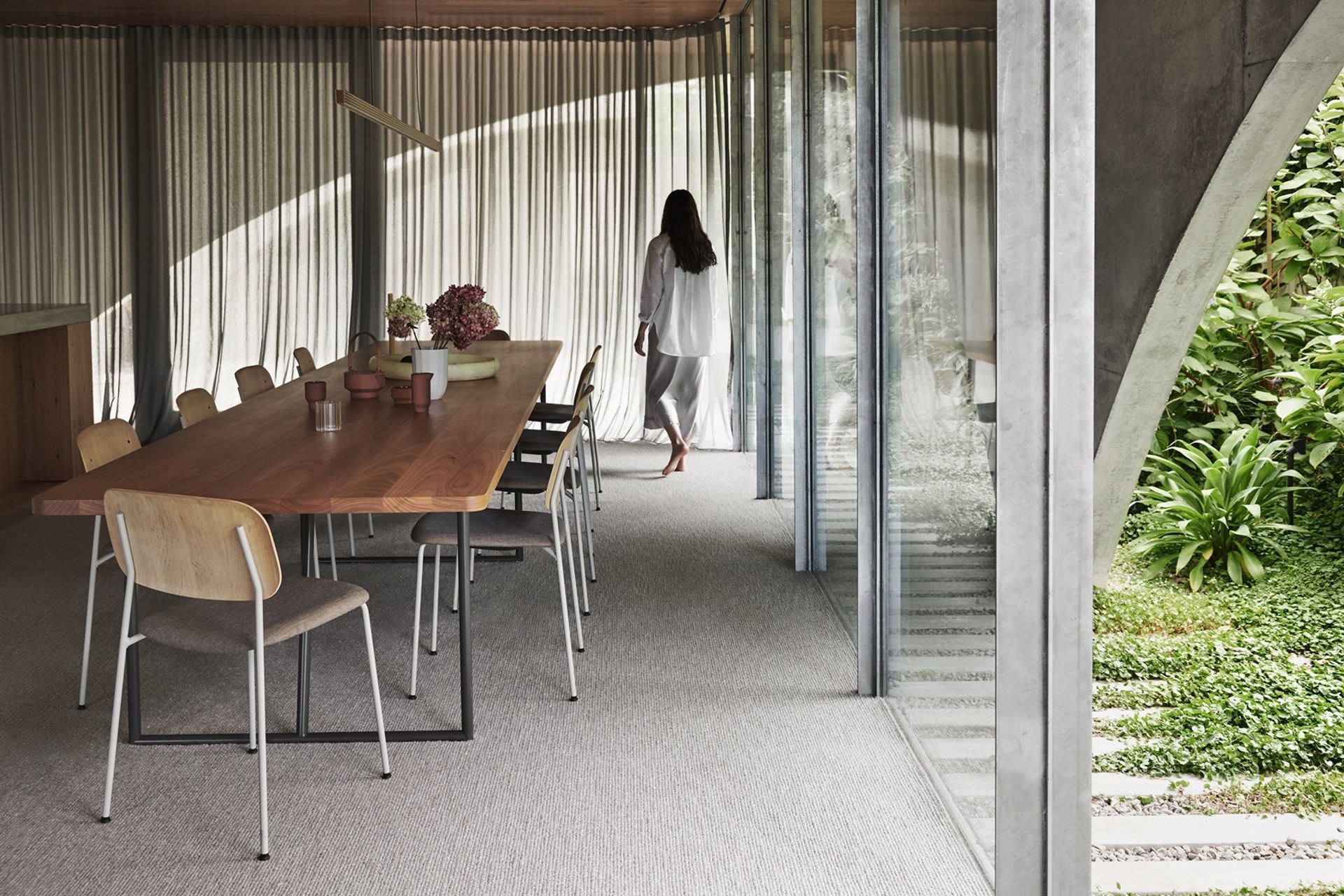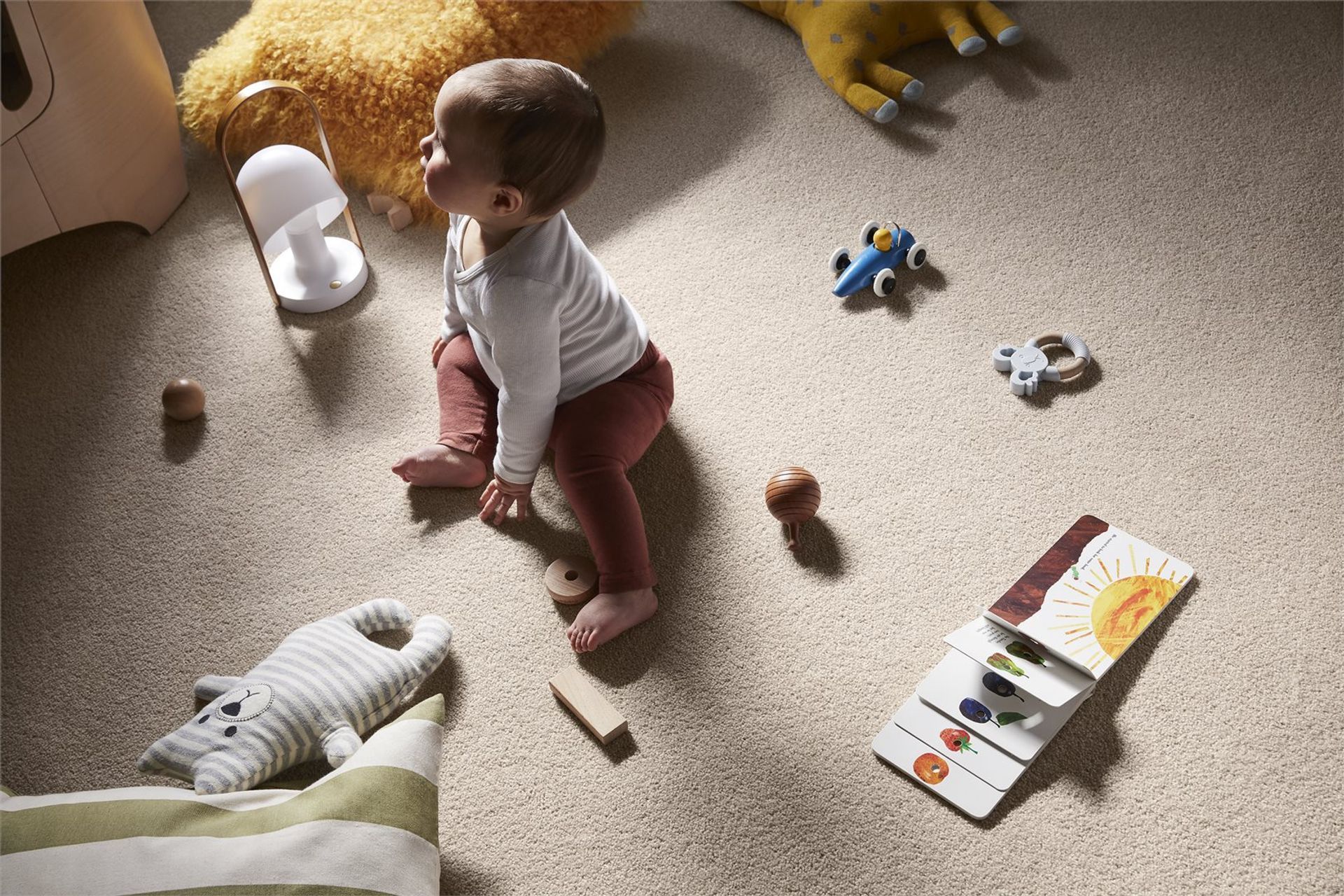A comprehensive guide to carpet underlay: materials, benefits and more
Written by
21 March 2024
•
9 min read

The quality of carpet underlay has a big impact on the living experience of a space and home, more so than you might think. While it does not influence the visual space, it does touch upon nearly all the other senses so is not something you want to take lightly. That's why we've put together this comprehensive guide that covers all the fundamentals so you can make the best choice for your home.
What is carpet underlay?
Carpet underlay is a crucial component of a home's flooring that is tucked away beneath the surface of a carpet, improving the comfort, durability, and overall performance. This layer, typically made from materials like rubber, foam, or felt, acts as a cushion that not only enhances the softness underfoot but also contributes to the insulation and soundproofing of a home. It also protects the carpet from wear and tear, prolonging its life, and helps maintain a comfortable indoor environment while also ensuring energy efficiency.
Related article: Choosing the right carpet for your home — a step-by-step guide
What are the benefits of carpet underlay?
Carpet underlay offer numerous benefits which can be quickly summarised as follows:
- Improves durability: Enhances the overall performance and longevity of carpet by reducing the wear and tear on it, helping to maintain its appearance over time.
- Improves comfort: Acts as a crucial cushioning layer that improves comfort underfoot.
- Improves insulation: Provides excellent insulation, keeping homes warmer in the winter and cooler in the summer, which can lead to energy savings.
- Dampens noise: Offers sound dampening properties, making rooms quieter by absorbing noise.
- Protects against moisture: Certain underlays come with moisture barriers, protecting the carpet and floor underneath from potential moisture damage.
Types of carpet underlay materials
The choice of carpet underlay material is important with a number of options to consider in New Zealand, each with its own traits and qualities to compare and contrast.
Rubber underlay
Rubber underlay stands out for its exceptional durability and ability to maintain its shape and support over time. Its typically available as sponge rubber underlay (similar to foam) and crumb rubber underlay (smaller chunks adhered to sheets) and offers superior noise reduction and moisture resistance. This makes it a preferred choice for areas requiring robust insulation and longevity.
Foam underlay
Foam underlay is made from lightweight, flexible materials like polyurethane (often called PU foam underlay), offering superior comfort and cushioning underfoot, which is distinct from the firmer support of rubber. Its unique ability to conform to the floor's shape provides excellent insulation and sound absorption, making it a great choice for enhancing the plushness and warmth of carpets in homes.
Felt underlay
Felt underlay, crafted from recycled fibres, offers an eco-friendly option that provides a dense, firm cushioning layer under carpets. Its natural composition not only contributes to better sound and thermal insulation but also ensures a sustainable choice for environmentally conscious homeowners.
Combination underlay
Combination underlay integrates materials like rubber and foam or felt and foam, offering a hybrid solution that balances comfort, durability, and insulation. This unique approach provides the resilience and moisture resistance of rubber with the softness and thermal benefits of foam or the eco-friendliness of felt, making it versatile for various needs and preferences.
Understanding underlay thickness and density
Thickness and density are two of the most important traits to understand when looking at carpet underlay with products often described by these two factors specifically, for example, carpet underlay 110kg x 12mm. Knowing how these traits influence performance is crucial to picking the right option for the room in question.
Thickness
The thickness of carpet underlay plays a pivotal role in determining the comfort, insulation, and longevity of carpeted flooring. In New Zealand, the thickness of an underlay generally ranges from 7mm - 12mm giving you a variety of options to consider. A thicker underlay generally provides enhanced cushioning, which not only improves the feel of the carpet underfoot but also contributes to better thermal and acoustic insulation. However, thick underlay is more prone to compression which can be an issue for high traffic areas, accelerating wear and tear. Thick underlay can also be tricky to install around tight spaces like staircases and may inhibit the effectiveness of underfloor heating if you have a system installed.
Density
The density of carpet underlay also significantly impacts the performance, durability, and feel of carpeted floors. Density, measured in kilograms per cubic metre (kg/m³), influences how well the underlay can support the carpet, resist foot traffic, and maintain its shape over time. A higher density underlay will typically offer better support and longevity, making it ideal for high traffic areas, whereas lower density options might provide more comfort but less resilience. The density range for carpet underlay in New Zealand varies widely, from around 80 kg/m³ - 140 kg/m³.
Other important traits
Besides the key factors of thickness and density, there are a number of other important traits to also bear in mind.
Thermal insulation
Homes in New Zealand haven't historically been well insulated and high-quality carpet underlay presents a great opportunity to make significant improvements in this area. The insulating properties of underlay are usually expressed in tog or R-value (1 tog = R-value x 10), units that quantify thermal resistance. A higher R-value or tog value indicates better insulation, with underlay tog ratings can range from about 1 tog, offering minimal insulation, to 3.5 tog or higher, providing substantial thermal resistance. Typically somewhere between 2.9 - 3.5 tog is what most homeowners will opt for.
Acoustic insulation
Acoustic insulation properties of underlay are incredibly important for those living in multi-level homes as they can help reduce noise transmission between floors and rooms. The effectiveness of an underlay in providing acoustic insulation is measured in decibels (dB), with this unit quantifying the sound energy reduction achieved by the underlay. Higher dB ratings indicate more effective noise reduction, making such underlays an essential consideration for creating quieter, more serene indoor environments. Most high-quality options boast somewhere between 40 - 50dB in acoustic insulation.
Moisture resistance
Moisture resistance is a good quality to prioritise in this country being one that is particularly humid. It is also a handy thing to have for areas prone to spills or for those who have kids and/or pets in the house. A lot of modern carpet underlays will include some sort of moisture resistance feature, often in the form of a thin laminate coating. The main choice will be the degree of moisture resistance which is typically described as opposed to measured by any particular metric.
Antimicrobial properties
The antimicrobial properties of a carpet underlay helps maintain a healthy indoor environment, understandably an important issue for most homeowners. Antimicrobial underlays are treated with agents that inhibit the growth of bacteria, mould, and mildew. They are particularly significant for households with allergy sufferers, as it helps to reduce the presence of allergens too. By preventing the growth of unwanted microbes, antimicrobial underlays extend the life of both the underlay and the carpet.
Factors to consider when choosing carpet underlay
Having covered the traits and qualities of different types of carpet underlay, you need to think about which are a priority for your given situation. The factors that will influence your decision are typically the following.
Room being carpeted
The function of room being carpeted has a massive bearing on the type of underlay best suited to the space. For example, high-traffic areas like hallways and living rooms need underlays that can withstand constant footfall, in which case dense and durable underlays are best. Bedrooms and kids rooms, on the other hand, benefit from softer, thicker underlays.
Structural flooring material
The material used in the structural flooring have an influence as well. For concrete floors, underlays with decent moisture barriers are often recommended to prevent any dampness affecting the carpet flooring. A good wood floor underlay, however, is often one that offers better acoustic insulation. On top of this, if the condition of the subfloor is a little patchy, a denser and slightly thicker underlay might be required to ensure a smooth finish.
Type of carpet flooring
Different carpets, such as loop pile, cut pile, textured etc, may require specific underlays to support their structure and ensure longevity. For example, a denser underlay may be needed for heavier carpets to prevent too much compression. Carpet manufacturers often specify the type of underlay that best complements their product, which can also impact the warranty, which is another factor you should be aware of.
Related article: A guide to the different types of carpets for your home
Budget
The cost of the underlay, of course, has a major bearing on any decision. Given you'll also be paying for the price of the carpet itself, there may be limits to what you can additionally spend on underlay. Generally, the price you'll get quoted will include a standard underlay so you'll want to check its credentials and features first, which may be perfectly fine for your needs. If not, you'll want to think carefully about the above and prioritise which qualities you want and need to have and figure out what you're willing to pay for those features.
Everything you need to know about carpet underlays
Now that you've covered all there is to know about carpet underlay, you're in a great position to make a shortlist of options that will lead to your final choice. As you can see, there are some great benefits they can bring to a space but also quite a few factors to consider too. So long as you take a thorough and pragmatic approach, you'll ensure you pick something that fulfils all your requirements and more.

